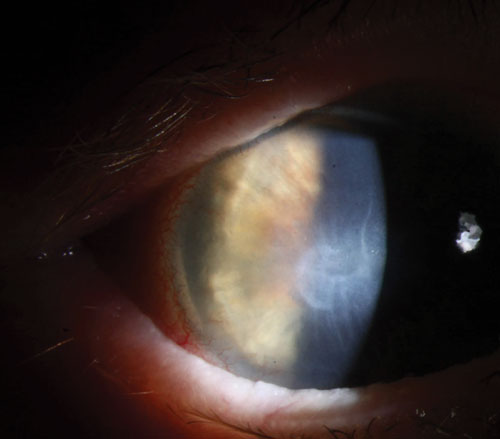A new treatment for corneal scarring using stem cells grown from the patient’s healthy stroma could one day reduce the need for grafts, according to research published in the December 2014 Science Translational Medicine.1
“The body usually responds to corneal injuries by making scar tissue. We found that delivery of stem cells initiates regeneration of healthy corneal tissue rather than scar, leaving a clear, smooth surface,” says senior investigator James L. Funderburgh, PhD, associate director of the Louis J. Fox Center for Vision Restoration of the University of Pittsburgh.
The purpose of the study was (1) to determine if mesenchymal stem cells present in limbal biopsy-derived stromal cells (LBSCs) differentiate into corneal keratocytes in vitro and (2) to evaluate whether LBSCs can prevent corneal scarring.

| |
| Stem cells may be able to regenerate tissue in corneal scarring patients. Photo: Christine Sindt, OD |
The researchers first obtained and cultured LBSCs from tissue harvested from the limbus region of human donor corneas. The cells proliferated quickly, and were then tested to determine that they had indeed become keratocytes. In the second half of the study, researchers used fibrin glue to engraft the cells onto the debrided corneas of mice. A separate control population was similarly debrided, but without the addition of LBSCs.
OCT performed at two and four weeks after debridement showed a marked increase in light scatter in the untreated scars; conversely, light scatter in the LBSC-treated scars was similar to levels in the preoperative normal corneas. Transmission electron micrography also revealed that collagen organization in the stroma appeared similar to that of native tissue in the LBSC-treated corneas. Reduced corneal vascularization in response to the LBSC treatment was also observed.
“Even at the microscopic level, we couldn’t tell the difference between the tissues that were treated with stem cells and undamaged cornea,” Dr. Funderburgh says. “We were also excited to see that the stem cells appeared to induce healing beyond the immediate vicinity of where they were placed. That suggests the cells are producing factors that promote regeneration, not just replacing lost tissue.”
The study suggests LBSCs could eventually be used to treat corneal scarring in humans. Indeed, a small pilot study based on this research—in which a handful of patients will receive their own corneal stem cells as treatment—is underway in India.
1. Basu S, Hertsenberg AJ, Funderburgh ML, et al. Human limbal biopsy-derived stromal stem cells prevent corneal scarring. Sci Transl Med. 2014 Dec 10;6(266):172.


